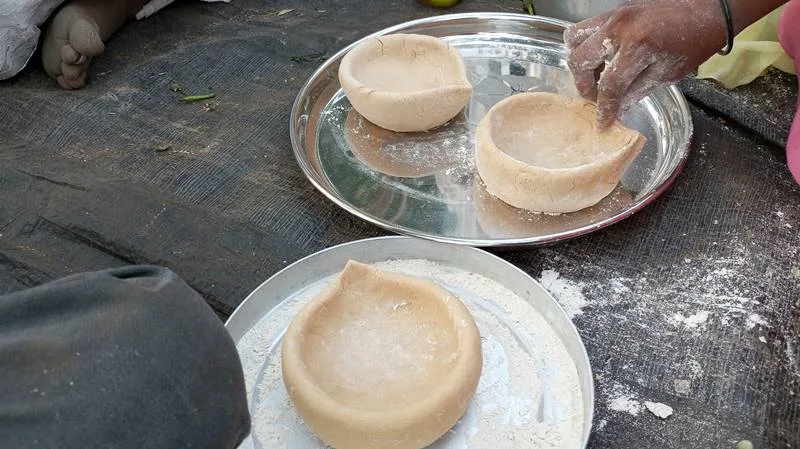A Glimpse into the Great Dongrya Dev Festival: Mountain God Festival
Dongrya Dev डोंगऱ्या देव (Mountain God) is an annual festival observed in the tribal regions of Maharashtra during the month of Margashirsha (November-January).
It is the biggest festival among the tribal communities in Maharashtra and certain other regions of India. This festival is observed with immense joy and devotion.
The main purpose of the festival is to seek blessings from the nature deity, the Mountain god. It's a time when villagers come together to wish for happiness and peace in their community. They pray for good harvests in the fields and, for happiness and prosperity in their homes and families.The courtyard is cleaned with Cow dung and Cow urine (Go tel). Devotees place a pylon of Umbar tree (cluster fig tree) in the courtyard and worship the marigold plant as a deity. A sacred pole called a 'Devadanda' is set up by five Maulis. Marigold seedlings are then planted around this pole.
A lamp (big diya) is placed next to this sacred pole 'Devadanda' along with a bunch of peacock feathers, cucumber, nagli seeds, and uradda seeds. This small space is called "Thomb".To fulfill the promises made to the mountain god, the priest, known as Shevarya Mauli, chants mantras during the worship ceremony. This ceremony takes place in the presence of the Bhopa Mauli (Servant of God), Davari Mauli (assistant priest), and the villagers.
The Maulies dance around the Thomb to the rhythmic beats of the Valtyas, which are songs dedicated to the mountain gods, accompanied by the melodious tunes of Pawari (a tribal musical instrument).These songs describe different tribal deities, praising them while dancing together. As the song's lines change, the dance style also changes accordingly.
Lasting for about 15 days, devotees partake in a special observance, consuming a diet limited to groundnuts, jaggery, and corn in the morning. The fast is broken by eating Udid dal and Bajra roti at night.During the festival, the tribal brothers (Maulies) and their leaders visit nearby villages in groups. They sing songs about the Mountain God and invite the villagers to come and have Darshan. The villagers invite the Maulies and offer grains, oil, salt, or money to them.
This festival typically lasts from the sighting of the moon to the full moon.
On the day before the full moon, known as Chaturdashi, the Devadanda is taken to a specific mountain near the village for worship. On this special night, the Maulies come together to dance and sing under the rays of the full moon. Their celebration honors the mountain god, and their songs and dances are a way to show their thanks.
When the full moon shines bright, the Shevarya Mauli (priest) prays to the mountain god for blessings and protection for all living things, including birds, animals, and people.
Upon returning home, a village feast (Bhandara) is held in the evening, signaling the conclusion of the festival.
It is the biggest festival among the tribal communities in Maharashtra and certain other regions of India. This festival is observed with immense joy and devotion.
The main purpose of the festival is to seek blessings from the nature deity, the Mountain god. It's a time when villagers come together to wish for happiness and peace in their community. They pray for good harvests in the fields and, for happiness and prosperity in their homes and families.The courtyard is cleaned with Cow dung and Cow urine (Go tel). Devotees place a pylon of Umbar tree (cluster fig tree) in the courtyard and worship the marigold plant as a deity. A sacred pole called a 'Devadanda' is set up by five Maulis. Marigold seedlings are then planted around this pole.
A lamp (big diya) is placed next to this sacred pole 'Devadanda' along with a bunch of peacock feathers, cucumber, nagli seeds, and uradda seeds. This small space is called "Thomb".To fulfill the promises made to the mountain god, the priest, known as Shevarya Mauli, chants mantras during the worship ceremony. This ceremony takes place in the presence of the Bhopa Mauli (Servant of God), Davari Mauli (assistant priest), and the villagers.
The Maulies dance around the Thomb to the rhythmic beats of the Valtyas, which are songs dedicated to the mountain gods, accompanied by the melodious tunes of Pawari (a tribal musical instrument).These songs describe different tribal deities, praising them while dancing together. As the song's lines change, the dance style also changes accordingly.
Lasting for about 15 days, devotees partake in a special observance, consuming a diet limited to groundnuts, jaggery, and corn in the morning. The fast is broken by eating Udid dal and Bajra roti at night.During the festival, the tribal brothers (Maulies) and their leaders visit nearby villages in groups. They sing songs about the Mountain God and invite the villagers to come and have Darshan. The villagers invite the Maulies and offer grains, oil, salt, or money to them.
This festival typically lasts from the sighting of the moon to the full moon.
On the day before the full moon, known as Chaturdashi, the Devadanda is taken to a specific mountain near the village for worship. On this special night, the Maulies come together to dance and sing under the rays of the full moon. Their celebration honors the mountain god, and their songs and dances are a way to show their thanks.
When the full moon shines bright, the Shevarya Mauli (priest) prays to the mountain god for blessings and protection for all living things, including birds, animals, and people.
Upon returning home, a village feast (Bhandara) is held in the evening, signaling the conclusion of the festival.
























Post a Comment